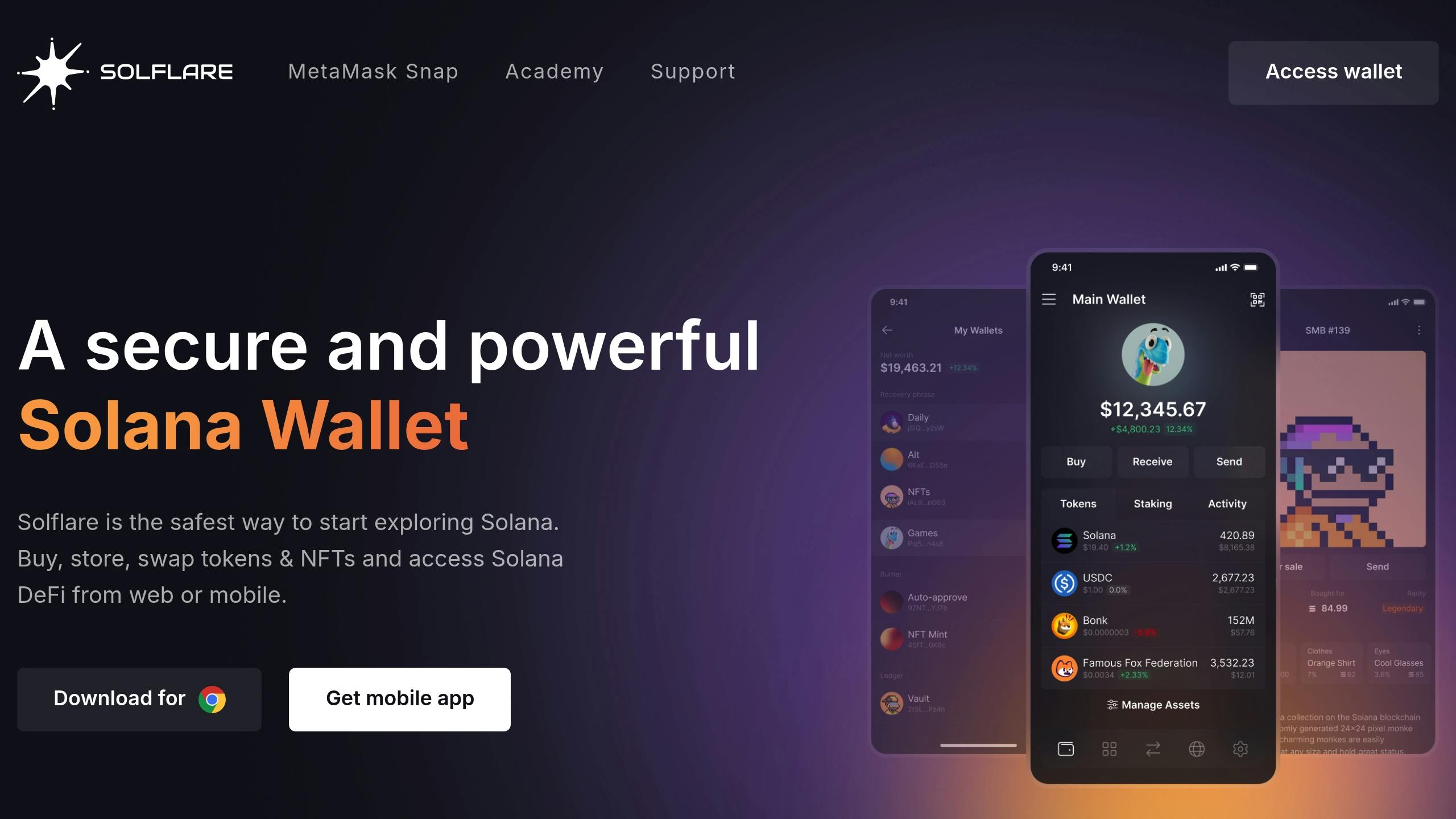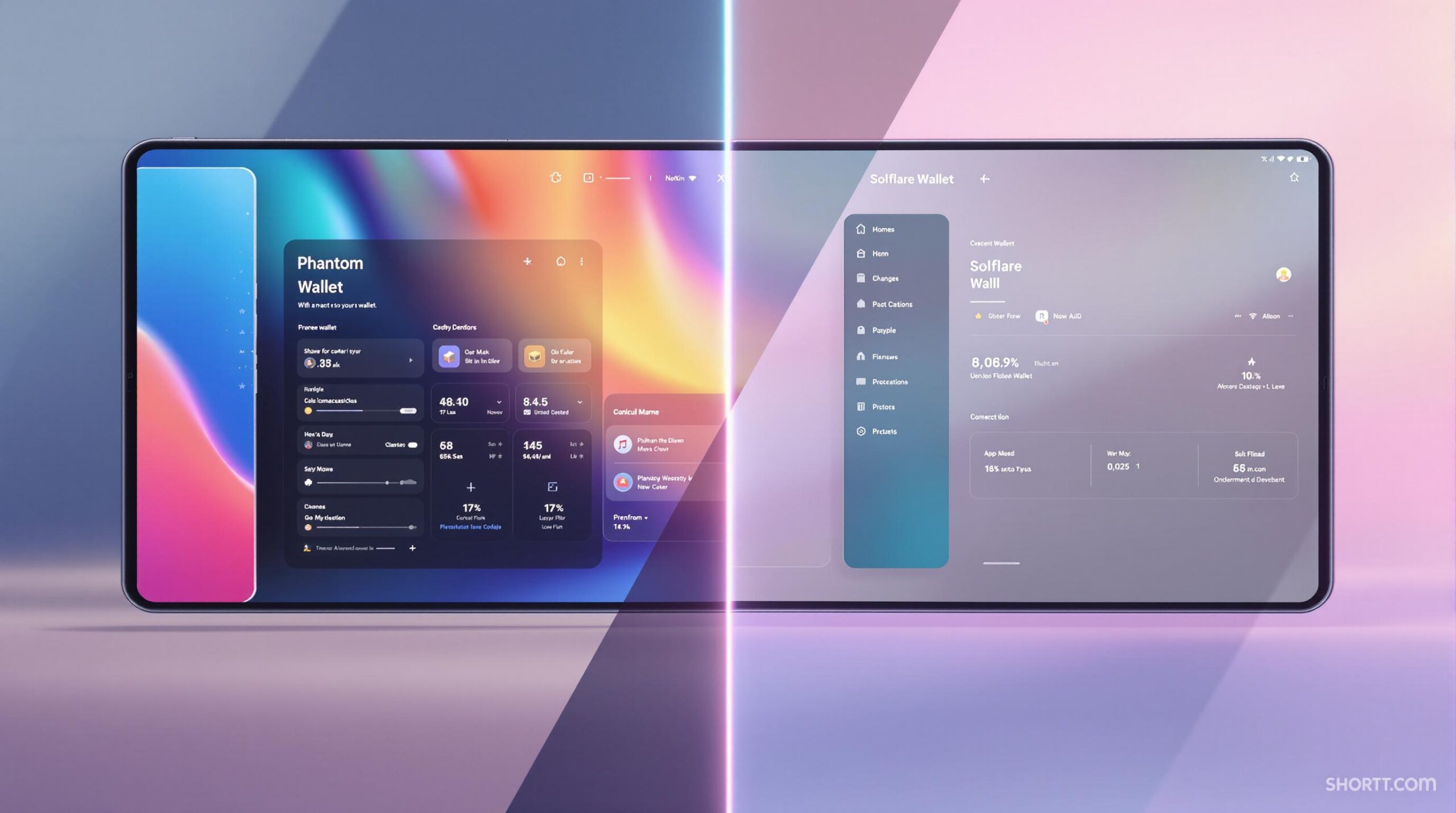Looking for the best wallet for Solana? Phantom and Solflare are two top options, but they serve different needs. Here’s a quick comparison to help you decide:
- Phantom: Best for multi-chain users, NFT collectors, and those who prefer simplicity. Supports Solana, Ethereum, Bitcoin, and Polygon.
- Solflare: Ideal for advanced Solana stakers and data-driven traders. Focused exclusively on Solana with detailed staking tools and analytics.
Quick Comparison
| Feature | Phantom | Solflare |
|---|---|---|
| Chain Support | Multi-chain (SOL, ETH, BTC, MATIC) | Solana-only |
| Staking Tools | Basic staking | Advanced analytics, 650+ validators |
| NFT Management | In-wallet sales, metadata display | Portfolio tracking, value estimates |
| Mobile Features | Biometric login, multi-chain swaps | Custom staking dashboard |
| Security | Real-time scam detection | Pre-execution transaction testing |
| dApp Integration | Simplified, 2-click swaps | Detailed routing, batch transactions |
Bottom Line: Choose Phantom for ease of use and cross-chain functionality. Go with Solflare if you’re focused on Solana staking and advanced trading tools.
Key Features
Feature Comparison
Phantom and Solflare take different approaches to managing Solana assets. Phantom supports multiple blockchains, including Solana, Ethereum, Bitcoin, and Polygon [5][6]. In contrast, Solflare focuses exclusively on Solana [1][9], tailoring its features specifically to that ecosystem.
| Feature Category | Phantom | Solflare |
|---|---|---|
| Chain Support | Multi-chain (SOL, ETH, BTC, MATIC) | Solana-only |
| Staking Features | Basic staking tools | 650+ validators, detailed analytics |
| NFT Management | In-wallet sales, metadata display | Portfolio tracking, value estimates |
| Mobile Features | Multi-chain swaps, biometric login | Custom staking dashboard |
| Transaction Tools | Basic priority fees | Advanced fee control, batch transactions |
These differences reflect distinct user priorities. Phantom’s streamlined interface contrasts with Solflare’s detailed analytics and tools. For example, 78% of users found Phantom’s swap interface faster in testing [5], while 68% of active stakers favored Solflare’s analytics dashboard [9].
Main Differences
Breaking it down further, here are key areas where the wallets diverge:
Phantom focuses on:
Solflare emphasizes Solana-specific tools, including:
- Advanced stake pool creation and management [9].
- A pre-execution transaction testing environment [8].
- Detailed validator performance metrics for better selection [2].
Phantom lacks advanced order types and validator analytics, while Solflare doesn’t offer cross-chain bridges or advanced NFT trading tools.
Solflare also provides more control for traders with features like manual fee adjustments and batch transactions [9]. On the other hand, Phantom opts for simplicity with a more accessible fee structure.
When it comes to NFTs, both wallets handle basic storage and transfers [1][5]. However, Phantom integrates directly with marketplaces for in-wallet trading [7][5], while Solflare offers portfolio tracking with value estimates for collections [9].
These differences significantly impact trading efficiency on Solana DEXs – something we’ll dive deeper into in the dApp Support section.
Solflare Wallet vs Phantom (2025) | Which One is Better?

Security and Privacy
For DEX traders, security features play a key role in managing risks, especially during leveraged positions.
Security Tools
Phantom and Solflare both prioritize security but take different approaches to protect users. Phantom focuses on real-time threat detection, analyzing transaction patterns to flag potential scams. It also relies on an open-source blocklist that is regularly updated by community contributions [7][4]. On the other hand, Solflare emphasizes pre-execution transaction testing to identify malicious activity before it happens [3][8]. Additionally, Solflare includes domain-level anti-phishing checks to guard against fake websites.
Here’s how their security features compare:
| Security Feature | Phantom | Solflare |
|---|---|---|
| Authentication | Biometric + Password | Password + Optional 2FA |
| Transaction Protection | Scam detection for fraudulent swaps | Simulation to block smart contract exploits |
| Key Storage | iOS-grade secure enclave encryption | Multi-party computation (MPC) |
| Vulnerability Response | 24-hour critical patch deployment | 24-48 hour fix SLA |
| Bug Bounty Program | Up to $50k rewards | Not publicly documented |
Phantom’s security has been verified through three public audits conducted by Kudelski Security since early 2024 [7][4]. Solflare, while not publicly audited, ensures transparency by using community-vetted open-source components [3][8].
Hardware Wallet Support
Hardware wallets are essential for secure large-scale DEX trades. Phantom provides full Ledger support, including Bluetooth-enabled features for mobile users with Ledger Nano X and S Plus models [7][4]. This makes it a strong choice for traders who need mobile flexibility.
Solflare, however, focuses on desktop integration, supporting hardware wallets via USB connections [3][5]. While this limits mobile usability, it adds an extra layer of security by requiring additional confirmation steps during transactions.
"Phantom’s rapid response to the 2021 Demonic vulnerability established its security credibility, implementing new seed protocols that prevented major losses [10]."
Privacy Protection
Both wallets prioritize user privacy. Phantom avoids collecting personal information or IP addresses, ensuring user anonymity [7][4]. Solflare also maintains privacy but offers an optional email recovery feature for added convenience [3][8]. Importantly, neither wallet stores seed phrases or private keys on their servers, giving users full control over their assets.
For advanced users managing large portfolios, Phantom provides vaults with spending limits, while Solflare automatically revokes dApp access after each session for added security.
sbb-itb-dd9e24a
dApp Support and Access
DEX and DeFi Tools
When it comes to interacting with decentralized exchanges (DEXs), Phantom and Solflare take different approaches:
- Phantom simplifies things with one-click swaps through the Jupiter Aggregator, making SOL-to-USDC trades as easy as two clicks [5][6].
- Solflare, on the other hand, offers a more detailed process with manual routing. While this takes more steps, it gives experienced users more control. Solflare also shines in staking, managing over $14 billion in staked SOL [3].
| Feature | Phantom | Solflare |
|---|---|---|
| DEX Integration | Direct in-wallet swaps | External DEX routing |
| Trading Steps | 2-click process | 4+ step process |
| Staking Interface | Real-time APY dashboard | Validator analytics |
| DeFi Protocols | Marinade Finance, Tensor | Marinade Finance, StakeView |
Platform Support
Phantom offers consistent features across platforms. Its mobile apps include WalletConnect, making it compatible with a wider range of dApps. Plus, its cross-device sync ensures smooth transitions between devices [4][5][6].
Solflare provides a built-in dApp browser for easier ecosystem navigation [3]. However, its mobile app has limitations – staking with hardware wallets, for example, is only available on desktop, not Android [3][8].
Currently, 78% of Solana dApps prioritize Phantom integration, while Solflare leads in validator tools, thanks to its analytics API [2][3][5].
"The integration statistics show a clear preference among dApp developers, with Phantom’s extensive user base driving prioritized support across the ecosystem [5]."
These differences affect how users manage leveraged positions. Phantom simplifies complex transactions with clear summaries, while Solflare provides raw data, catering to more technically skilled users [1][3]. Each wallet’s features fit distinct user needs – a topic we’ll dive into further in the Best Uses section.
Best Uses and User Types
Best Uses for Phantom
The Phantom wallet is designed for users who want a straightforward multi-chain experience. With over 2 million active users [5], it stands out for:
- Cross-chain traders: They can easily manage assets across multiple blockchains thanks to Phantom’s multi-chain setup [5].
- Mobile-first users: Its iOS and Android apps offer features like biometric authentication and WalletConnect, making mobile trading smooth and secure [4].
- NFT collectors: Phantom simplifies NFT management with features like rarity filters and visual galleries [6][7].
| User Type | Key Benefits |
|---|---|
| New Crypto Users | Easy-to-use interface with step-by-step onboarding |
| Mobile Traders | Seamless mobile experience with device synchronization |
| NFT Enthusiasts | Integrated marketplace tools and collection features |
Best Uses for Solflare
Solflare is tailored for users deeply involved in the Solana ecosystem, especially those focused on staking and analytics. It’s a strong choice for:
- Professional stakers: Solflare provides detailed tools for selecting validators, including:
- APY comparisons (around 7% on average) [3]
- A testing environment to simulate transactions (covered in the Security section)
- DeFi power users: They gain access to advanced liquidity controls and trading customization options.
- Data-driven traders: Solflare’s web interface includes detailed analytics, validator metrics, and simulated transactions, helping users make informed decisions [3].
The wallet also offers separate tabs for DeFi positions and staking pools, giving users precise control over their portfolios. While these features are great for experienced users, they might feel overwhelming to beginners.
Solflare’s tools are ideal for those who need detailed control and analytics, making it a go-to choice for advanced users. This focus on precision will be revisited in our final recommendations.
Summary and Choice Guide
Here’s a breakdown of data-backed insights to help you decide:
| Feature Priority | Phantom | Solflare |
|---|---|---|
| Chain Strategy | Multi-chain swaps | Solana-focused tools |
| Trading Style | One-click execution | Customizable batch options |
| Institutional Use | Vault protections | Multi-sig & CSV exports |
When trading on Solana DEXs with leverage, keep these recommendations in mind:
- If cross-chain collateral management is a priority, Phantom simplifies asset transfers across SOL, ETH, and POLYGON networks [5].
- For yield farming precision, Solflare offers detailed validator selection and performance tracking [1].
Recommendations by User Type
- New DeFi users: Go with Phantom for its straightforward automated swaps.
- Yield farmers: Opt for Solflare to leverage its validator analytics.
- Cross-chain traders: Choose Phantom for its robust bridge support.
- Institutions: Use Solflare for its advanced reporting tools.
Phantom’s 2024 audit highlights its focus on security [7], while Solflare’s detailed fee structure makes it ideal for high-volume traders [9].
